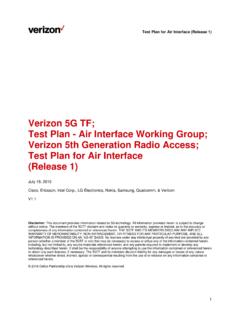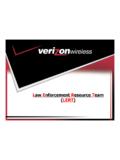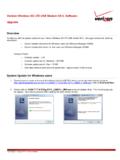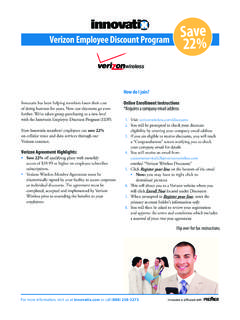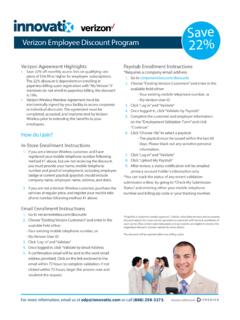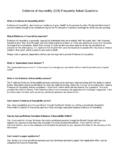Transcription of Verizon 5G TF; Network and Signaling Working Group ...
1 TS (2016-06) 1 Verizon 5G TF; Network and Signaling Working Group ; Verizon 5th Generation Radio Access; Overall Description (Release 1) June 29, 2016 Cisco, Ericsson, Intel Corp., LG Electronics, Nokia, Samsung Electronics, Qualcomm Technologies Inc. V Disclaimer: This document provides information related to 5G technology. All information provided herein is subject to change without notice. The members of the 5 GTF disclaim and make no guaranty or warranty, express or implied, as to the accuracy or completeness of any information contained or referenced herein. THE 5 GTF AND ITS MEMBERS DISCLAIM ANY IMPLIED WARRANTY OF MERCHANTABILITY, NON-INFRINGEMENT, OR FITNESS FOR ANY PARTICULAR PURPOSE, AND ALL INFORMATION IS PROVIDED ON AN AS-IS BASIS.
2 No licenses under any intellectual property of any kind are provided by any person (whether a member of the 5 GTF or not) that may be necessary to access or utilize any of the information contained herein, including, but not limited to, any source materials referenced herein, and any patents required to implement or develop any technology described herein. It shall be the responsibility of anyone attempting to use the information contained or referenced herein to obtain any such licenses, if necessary. The 5 GTF and its members disclaim liability for any damages or losses of any nature whatsoever whether direct, indirect, special or consequential resulting from the use of or reliance on any information contained or referenced herein.
3 2016 Cellco Partnership d/b/a Verizon Wireless; All rights reserved TS (2016-06) 2 Document History Version Date Change Verizon POC 2016-03-04 Draft version created 2016-03-11 Updated based on initial review in workstream 2016-03-16 Updated based on email comments 2016-04-08 Updated based on conference call 5 2016-04-28 Updated based on F2F meeting 4 2016-06-29 Approved version Document Approvals Name Title Company Date of Approval TS (2016-06) 3 Table of Contents Scope 2 References 3 Definitions and abbreviations Definitions Abbreviations 4 Overall architecture Architecture principles Radio protocol architecture User plane Control plane Radio access Network identities 5 RAN-UE signalling: 5G-RRC Services and Functions RRC protocol states & state transitions Transport of NAS messages System Information RRC Connection Setup 6 RAN-CN signalling and user plane.
4 NG1-C and NG1-U 7 5G L2 user plane 5G Medium Access Control Services and Functions Logical Channels Mapping between logical channels and transport channels PDU Structure 5G Radio Link Control Services and Functions PDU Structure 5G Packet Data Convergence Protocol Services and Functions PDU Structure 8 Mobility Intra 5G-RAN Radio Link Failure TS (2016-06) 4 Measurements 9 ARQ 10 Scheduling Basic Scheduler Operation Measurements to Support Scheduler Operation 11 Carrier Aggregation Principles Layer 2 Structure 14 Security Overview and Principles Security termination points State Transitions and Mobility RRC_IDLE to RRC_CONNECTED RRC_CONNECTED to RRC_IDLE Intra 5G RAN Mobility AS Key Change in RRC_CONNECTED TS (2016-06) 5 1 Scope The present document provides an overview and overall description of the radio Network and protocol architecture of the Verizon 5G system for initial Fixed Wireless Use case.
5 2 References [1] 3 GPP TS : "3 GPP System Architecture Evolution: Security Architecture". 3 Definitions and abbreviations Definitions For the purposes of the present document, the following terms and definitions apply. 5G-RRC: the protocol used for Signaling between Verizon 5G radio Network and a UE. NG1-C: the protocol used for Signaling between Verizon 5G radio and core Network control plane Network function. Cell: combination of downlink and uplink resources Abbreviations 5G-NB 5G Node B 5G-RA 5G Radio Access 5G-RAN 5G Radio Access Network AM Acknowledged Mode ARQ Automatic Repeat Request HARQ Hybrid ARQ MAC Medium Access Control PDCP Packet Data Convergence Protocol PDU Protocol Data Unit RLC Radio Link Control RRC Radio Resource Control SDU Service Data Unit TM Transparent Mode UM Unacknowledged Mode xBCH 5G Broadcast Channel xBCCH 5G Broadcast Control Channel xCCCH 5G Common Control Channel xDCCH 5G Dedicated Control Channel xDL-SCH 5G Downlink Shared Channel xDTCH 5G Dedicated Traffic Channel xRACH 5G Random
6 Access Channel xUL-SCH 5G Uplink Shared Channel TS (2016-06) 6 4 Overall architecture Editor s note: Overall system architecture will be specified in Editor s note: The workstream will initially focus on 5G fixed wireless use case but assures forward compatibility for other use cases The 5G-RAN consists of 5 GNBs, providing the 5G-RA user plane (PDCP/RLC/MAC/PHY) and control plane (RRC) protocol terminations towards the UE. The 5 GNB are connected by means of the 5G1 interface to the NG core Network . The 5G-RAN architecture is illustrated in Figure 4-1 below. Figure 4-1: Overall Architecture Architecture principles See Radio protocol architecture In this subclause, the radio protocol architecture of 5G-RAN is given for the user plane and the control plane.
7 User plane The figure below shows the protocol stack for the user-plane, where PDCP, RLC and MAC sublayers (terminated in 5G-NB on the Network side) perform the functions listed for the user plane in subclause 7, ciphering, scheduling, ARQ and HARQ. 5G UE5G-RAN5G User plane function(s)5G Core control functionNG-1 CNG-1 UUuTS (2016-06) 7 Figure : User-plane protocol stack Control plane The figure below shows the protocol stack for the control-plane, where: - PDCP sublayer (terminated in 5 GNB on the Network side) performs the functions listed for the control plane in subclause 7, ciphering and integrity protection; - RLC and MAC sublayers (terminated in 5 GNB on the Network side) perform the same functions as for the user plane; - RRC (terminated in 5 GNB on the Network side) performs the functions listed in subclause 5.
8 - NAS control protocol (terminated in NG Core control function on the Network side) performs among other things: - EPS bearer management; - Authentication; - Security control. NOTE: The NAS control protocol is not covered by the scope of this TS and is only mentioned for information. Figure : Control-plane protocol stack eNBPHYUEPHYMACRLCMACPDCPPDCPRLC5 GNBeNBPHYUEPHYMACRLCMACMMERLCNASNASRRCRR CPDCPPDCP5 GNBNG Core control functionTS (2016-06) 8 Radio access Network identities The following 5G-RAN related UE identities are used at cell level: - C-RNTI: unique identification used for identifying RRC Connection and scheduling; - Temporary C-RNTI: identification used for the random access procedure; - Random value for contention resolution: during some transient states, the UE is temporarily identified with a random value used for contention resolution purposes.
9 5 RAN-UE signalling: 5G-RRC Editor s note: Device expected to be in RRC-CONNECTED. Idle mode needed for cell selection only. This subclause provides an overview on services and functions provided by the 5G-RRC sublayer. Services and Functions The main services and functions of the RRC sublayer include: - Broadcast of System Information related to the non-access stratum (NAS); - Broadcast of System Information related to the access stratum (AS); - Establishment, maintenance and release of an 5G-RRC connection: - Allocation of temporary identifiers between UE and E-UTRAN; - Configuration of signalling radio bearer(s) for RRC connection: - Security functions including key management; - Establishment, configuration, maintenance and release of point to point Radio Bearers.
10 - Mobility functions including 5G cell addition/release, UE measurement reporting, control of the reporting and UE based mobility; - NAS direct message transfer to/from NAS from/to UE. RRC protocol states & state transitions RRC uses the following states: - RRC_IDLE: - PLMN selection; - Broadcast of system information; - Cell selection mobility; TS (2016-06) 9 - RRC_CONNECTED: - UE has a 5G-RRC connection; - UE has context in 5G-RAN; - Network can transmit and/or receive data to/from UE; - At PDCP/RLC/MAC level: - UE can transmit and/or receive data to/from Network ; - UE monitors control signalling channel for shared data channel to see if any transmission over the shared data channel has been allocated to the UE; - UE also reports channel quality information and feedback information to 5G-NB.
